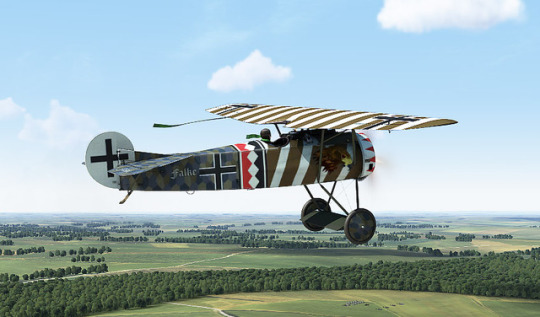#Fokker DVII
Text

1918 07 Löwenhardt - Russell Smith
repost better quality and size
Löwenhardt features the legendary yellow Fokker DVII of Oberleutnant Erich Löwenhardt, Germany's 3rd ranking ace of WW1, behind only Manfred von Richthofen and Ernst Udet. Löwenhardt was an aggressive, skilled fighter whose score grew steadily. At the end of May 1918 he received Germany's highest honor, the Pour le Mérite (Blue Max) after 24 kills. Flying the new Fokker D.VII, he added eight more in June and no fewer than 16 in July. His tally climbed to 53 on August 9.After scoring his 54th victory, he collided with Leutnant Alfred Wenz of Jasta 11. Both men jumped from their planes but Löwenhardt was killed when his parachute failed to open and he fell to his death from 12,000 feet.
35 notes
·
View notes
Text
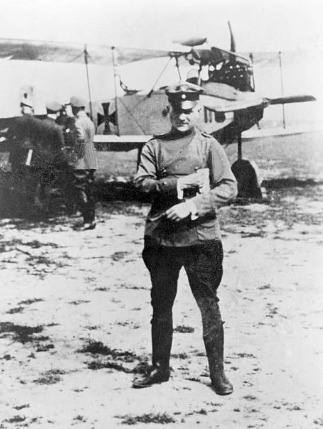
German fighter ace Manfred von Richthofen, known as the Red Baron, stands near a Fokker DVII biplane
35 notes
·
View notes
Text

1918 Fokker DVII strafing - by Michael Turner
@ron_eisele via X
32 notes
·
View notes
Text
The Far Side for Sunday 4/28.

Yes, Snoopy fought the Red Baron In the skies over Verdun in the the Meuse département, occupied France on January 30 1916 and was shot down behind enemy lines. After being captured In a small cafe in the village Belleville-sur-Meuse the next day, he was briefly held at the German compound at Sivry-sur-Meuse Aerodrome, 20 km NNE of Verdun. On 1 February 1916 he escaped in a stolen Fokker DVII, and was shot down AGAIN, this time by Nieuports flown by his own squadron, but behind Allied lines. He lived to fight another day...
7 notes
·
View notes
Photo


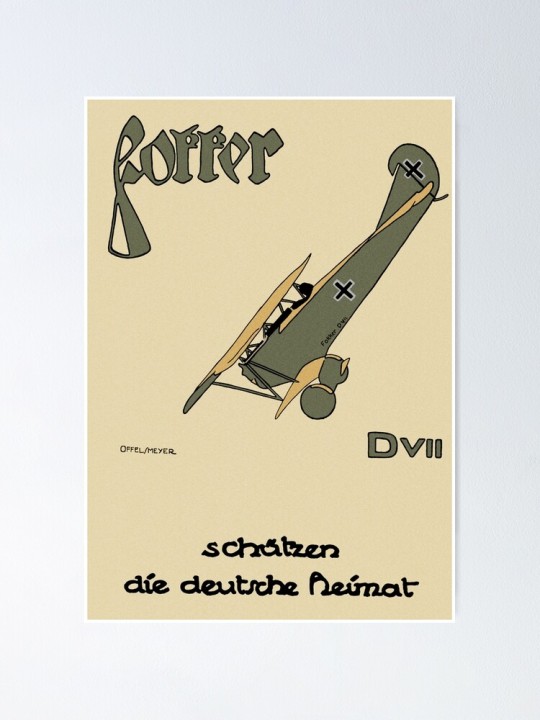
Fokker DVII by Offel / Meyer
Digitally rebulit.
Available now on poster, stickers, mugs, t-shirts and more.
On Ran.D
If you liked it, please share and help us reach more people with the same good taste as you ;).
0 notes
Video
de Havilland DH9A ‘F1010’ by Alan Wilson
Via Flickr:
c/n WA8459AMA Built 1918 and delivered to No110 (Hyderabad) Squadron, based at RAF Kenley. The squadron moved to France in August 1918 and began operations in September that year. It shot down a Fokker DVII on 25th September. On 5th October it force landed during a raid on Cologne, possibly with damage from fighters or anti-aircraft guns. The crew were uninjured and taken prisoner while the aeroplane was repaired and is believed to have been flown by the Germans. Stored in Germany after the war, she went on display in 1936 as part of the famous Berlin Air Museum, which had a collection of over 100 aircraft. The museums was badly damaged by a British bombing raid on the night of 23/24 November 1943 and the DH9 did sustain some damage. It was then moved to a ‘safe’ storage site in what was then Eastern Germany. The area was captured by Polish forces in March 1945 and is now part of Poland. The collection was moved to Poznan, later moving to Warsaw and then back to Poznan. By 1963 the aircraft were in Krakow with the Museum of Aviation and Aeronautics. The DH9 underwent some restoration work, although by now her wings were missing. In June 1977, after several years of negotiations, F1010 was swapped for Spitfire SM411, which remains on display in Krakow. The DH9 was brought to RAF Cardington where she was completely restored and new wings constructed. She went on display at Hendon in May 1983 and has remained here since, initially in Bomber Command Hall but later in the Main Hangars. She is now on display in Hangar 1 as part of the “RAF First 100 Years” exhibition. RAF Museum London. Hendon, Greater London, UK 3rd October 2020
8 notes
·
View notes
Photo

Fokker DVII (1918) sketch #aviationart https://www.instagram.com/p/CQ18FhSjzGM/?utm_medium=tumblr
1 note
·
View note
Photo
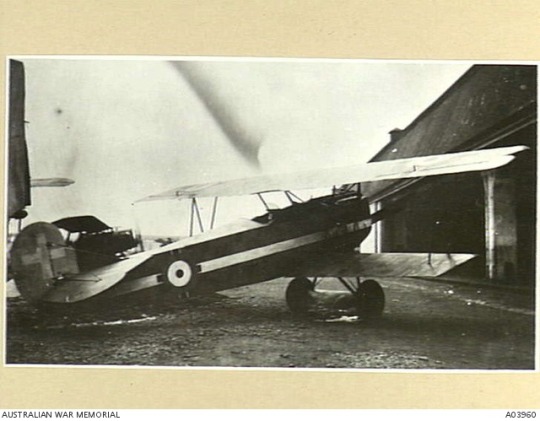
Captured German Fokker DVII in British colours.
14 notes
·
View notes
Photo

Fokker DVII, on Strafing Run over Trenches by Michael Turner
541 notes
·
View notes
Text

1918 05 Return from the Hunt - Russell Smith
Return From the Hunt features the Ostdeutsche Albatros Werke (O.A.W.) built Fokker DVII’s of Jasta 50. Jasta 50 was one of the first units to receive the O.A.W.-built D VIIs, with the planes arriving in mid-May of 1918. The fuselages of these particular DVII’s were covered with 4 color printed lozenge fabric. The wing rib tapes of these aircraft appear very light in photos, and often are referred to as light blue. However, it is far more likely that existing stocks of plain, unprinted fabric were used up at the factory for this purpose. The noses of O.A.W.-built D VIIs were painted dark green with mauve patches. On later machines, these patches were applied in a giraffe-style pattern. However on early examples, like this one, the mauve patches were applied in a cloud-like pattern. The unit and personal markings were applied with white and black paint of very good quality. The white used by Jasta 50 was so opaque that the printed camouflage pattern did not show through, and both colors were likely of factory quality. The lead aircraft is piloted by Lt. Karl Schädel. Schädel, whose name translated into English means “skull”, marked his DVII with a black skull smoking a pipe.
28 notes
·
View notes
Text
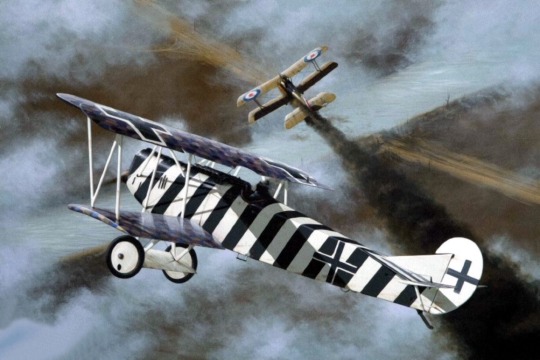
1918 Fokker DVII flown by Leutnant Josef Mai of Jasta 5
@ron_eisele via X
10 notes
·
View notes
Photo

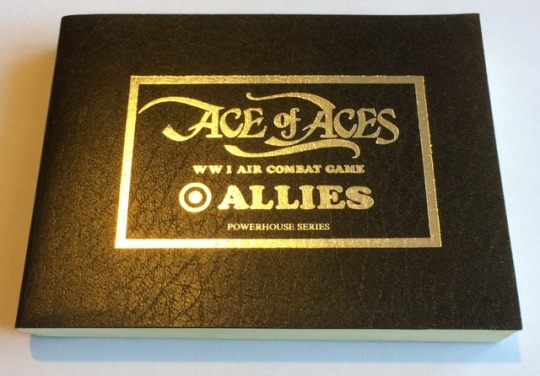

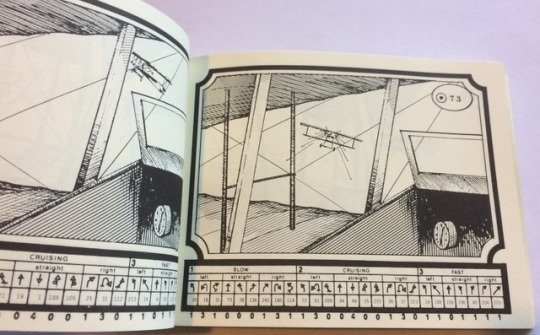
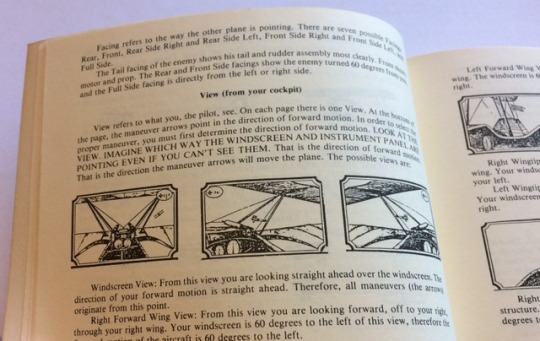
I WANT IT! LINK
From Wikipedia:
Ace of Aces is a two-player combat picture book game designed by Alfred Leonardi and first published in 1980 by Nova Game Designs. In 1981, Ace of Aces won the Charles Roberts/Origins Gamers Choice of 1980 and was inducted into the Adventure Gaming Hall of Fame in 1994.
In 1999, Pyramid magazine named Ace of Aces as one of the Millennium's Best Games.
Each set includes a pair of small books, one for each player (generally marked 'German' and 'Allied'). These are like gamebooks in that instead of reading through them, a person is 'at' one particular page, and the book represents a World War I fighter. Each player turns to the same page number in his book; the illustration on that page shows the view from the cockpit of his airplane, looking at the opponent. Along the bottom of the page is series of maneuvers that can be performed, with page numbers listed under them (while the page numbers are different with each page, the maneuvers are constant).
Via Boardgame Geek: Ace of Aces is an innovative 1-on-1 combat game that simulates a dogfight between WWI aircraft. Each player has a book with pictures of what they see out the cockpit of their airplane. Each player selects a maneuver (bank left, barrel roll, etc.) and tells their opponent a page number to turn to. This new page, when cross indexed with the maneuver made, gives the page number that shows the results of the chosen maneuver. The object of the game is to get your opponent in your sights and shoot them down.
There are advanced rules for fuel consumption as well as a campaign game.
The "Powerhouse Series" offered Ace of Aces fans their first chance to jump into another cockpit. The books in this set pit a Fokker DVII against a SPAD XIII.
#ace of aces#nova game designs#germans#allies#flight simulator#wwi#fokker#spad#powerhouse#dogfight#combat
2 notes
·
View notes
Text
Tweeted
RT ron_eisele: Died 26 May 1921, 8 victory German Fokker DVII ace with MFJ2, Vizeflugmeister Karl Scharon. pic.twitter.com/2uvRLW1UAb
— 段东升 (@dds0201) May 26, 2019
0 notes
Video
Fokker D.VII ‘8417/18’ by Alan Wilson
Via Flickr:
c/n 8417/18 One of only six remaining original Fokker DVII airframes, this example was left at Ostend, Belguim by retreating German forces in 1918. It is thought to have joined the Belgian Air Force, who operated the type until 1931. One of three to be civil registered in Belgium, it was later recovered from Versailles, France, in 1937 and returned to the UK to join the famous Nash collection. In 1953 the collection was purchased by the Royal Aeronautical Society and the DVII made several static public appearances at various events, along with other collection aircraft. In 1963 the collection aircraft were loaned to the RAF Museum and in 1966 the DVII was restored at RAF Henlow. After another string of appearances the aircraft finally went on permanent display at Hendon in 1979. A full and proper restoration began in 1993, with the aeroplane being returned as closely as possible to it’s 1918 condition. It returned to Hendon in 1997 and having previously been on display in the Milestones Building, it is now on display as part of the WW1 exhibition in the Grahame-White Hangar RAF Museum, Hendon, London, UK. 22-3-2015
12 notes
·
View notes
